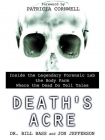Death's Acre: Inside The Legendary Forensic Lab The Body Farm Bill Bass (howl and other poems TXT) 📖

- Author: Bill Bass
Book online «Death's Acre: Inside The Legendary Forensic Lab The Body Farm Bill Bass (howl and other poems TXT) 📖». Author Bill Bass
It took us about ninety minutes to make the drive from Knoxville to the Hawkins County sheriff’s office in Rogersville; from there we followed a deputy—a Lieutenant Alvis Wilmot, who was heading the investigation—out a winding road along the north fork of the Holston River.
When you’re out in the country from Rogersville, population four thousand, you’re pretty far out there and pretty close to nowhere. By the time we turned down a gravel drive about twenty-five miles outside town, we were in a remote river valley, so sparsely populated—or maybe so suspicious of outsiders—that the fire hadn’t even been reported until a relative of the house’s owner drove down from Virginia and found the place in ruins. The property was heavily wooded and steeply sloped, angling down on the east side to the clear, green waters of the Holston’s north fork. We all got out and stretched our legs; Steve took some particularly deep breaths.
According to Lieutenant Wilmot, the blaze had occurred eight days before; as best they could tell from their interviews with the nearest neighbors, it probably began around two o’clock in the morning. By the time it had burned itself out, all that remained was a rectangle of charred rubble, bordered by a jumble of blackened bricks; a larger pile of bricks marked a spot near the center where a chimney had stood.
The house and land had been purchased just a month or so earlier by a Virginia man named James Grizzle, who hailed from an area even more mountainous and less populated than this one. Grizzle had moved into the house in December to begin remodeling it. The fire occurred on January 15; six days later, not having seen or heard from his son, Grizzle’s father had come looking and had promptly called the sheriff upon seeing that the house had burned. Our goal was to determine whether Grizzle’s body lay somewhere in the charred ruins left by the fire.
FORENSICALLY, fire scenes pose an interesting combination of circumstances and challenges. As at any death scene involving a decomposed body or bone, it’s important to locate and recover all the human remains; at a fire scene, though, that’s often difficult because of the dramatic changes a human body undergoes in an intense fire.
The arms and legs are the first to go. Relatively thin and surrounded by oxygen, they’re like kindling, easy to ignite and quick to burn. At temperatures of only a few hundred degrees, the skin quickly blackens, the fat beneath the skin starts to sizzle, and within a matter of minutes the skin splits open and the flesh begins to burn. As it does, something remarkable and eerie happens. The limbs begin to move—the hands and feet clench, the arms curl up toward the shoulders, and the legs spread slightly apart with the knees flexed. It’s a function of biomechanics and muscle strength: The flexors, the muscles that cause our arms and legs to bend, are stronger than the extensors, the ones that cause our limbs to straighten. As fire cooks and dries out the muscles and tendons of the body, they shrink, just like a steak on the grill, and the flexors overpower the extensors.
The resulting position is very much like a boxer’s stance in the ring; for that reason we call it the “pugilistic posture.” It’s very distinct and very consistent—as consistent in fire victims as a purplish color and swollen tongue are in hanging victims—so long as the limbs are free to flex. If, on the other hand, the arms are tied or pinned behind the back, they won’t be able to curl up, so finding a burned body whose arms are straight can be an important clue that the victim was somehow confined or restrained.
The other truly dramatic change that occurs is to the head. The skull is basically a sealed vessel, filled with fluid and moist brain tissue. It doesn’t take long for all that moisture to reach the boiling point and create pressure in the cranium; the hotter the fire, the greater the pressure. If there’s an outlet for that pressure—for example, a bullet hole in the skull—the pressure vents harmlessly. If there isn’t, the skull can literally burst, fracturing the cranium into numerous pieces, each about the size of a quarter. Recovering and reconstructing a skull from a fire scene is one of the most tedious tasks a forensic anthropologist ever faces, and even after it’s pieced together, that skull remains a challenge, since blunt-force or sharp-force trauma can be difficult to spot amid the myriad fire-induced fracture lines and the occasional gaps where pieces are missing.
Fortunately for crime scene investigators, it’s difficult to burn up a body entirely; even cremation leaves substantial portions of bone, which must then be pulverized mechanically. Still, even the biggest, most robust bones of the body—the femur and tibia in the leg, the humerus in the arm—can be badly damaged by a fire. A fairly low-temperature house fire will turn the long bones black or caramel-colored but leave them relatively intact structurally. An arson fire, though—one fueled by gasoline or some other flammable accelerant—can reach temperatures as high as 2,000 degrees Fahrenheit; at such extreme temperatures the bone undergoes a chemical and structural metamorphosis. Bone, like the rest of the body, contains carbon, and at extremely high temperatures that carbon burns out of the bone. What’s left behind, called “calcined” bone, might still retain its shape—just





Comments (0)